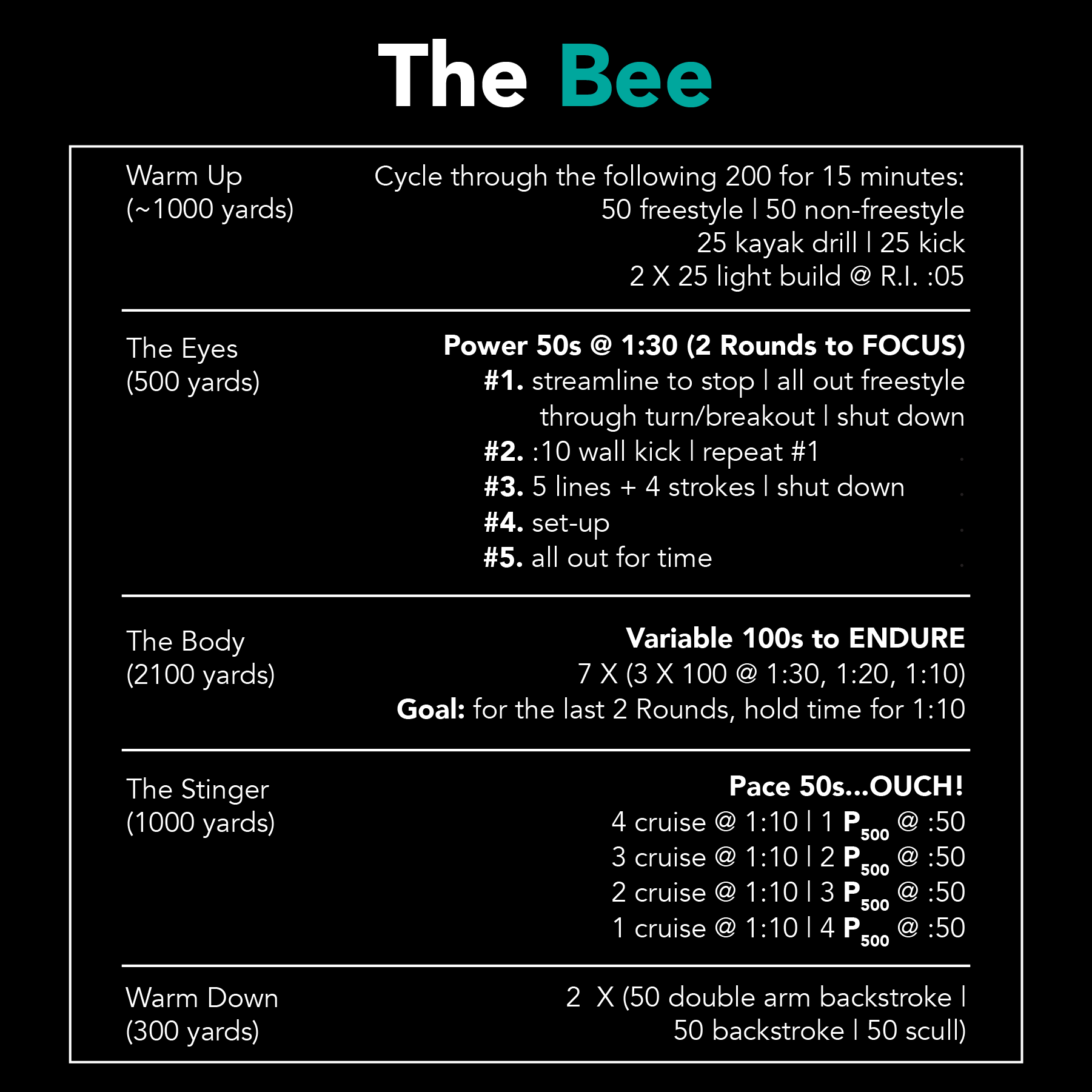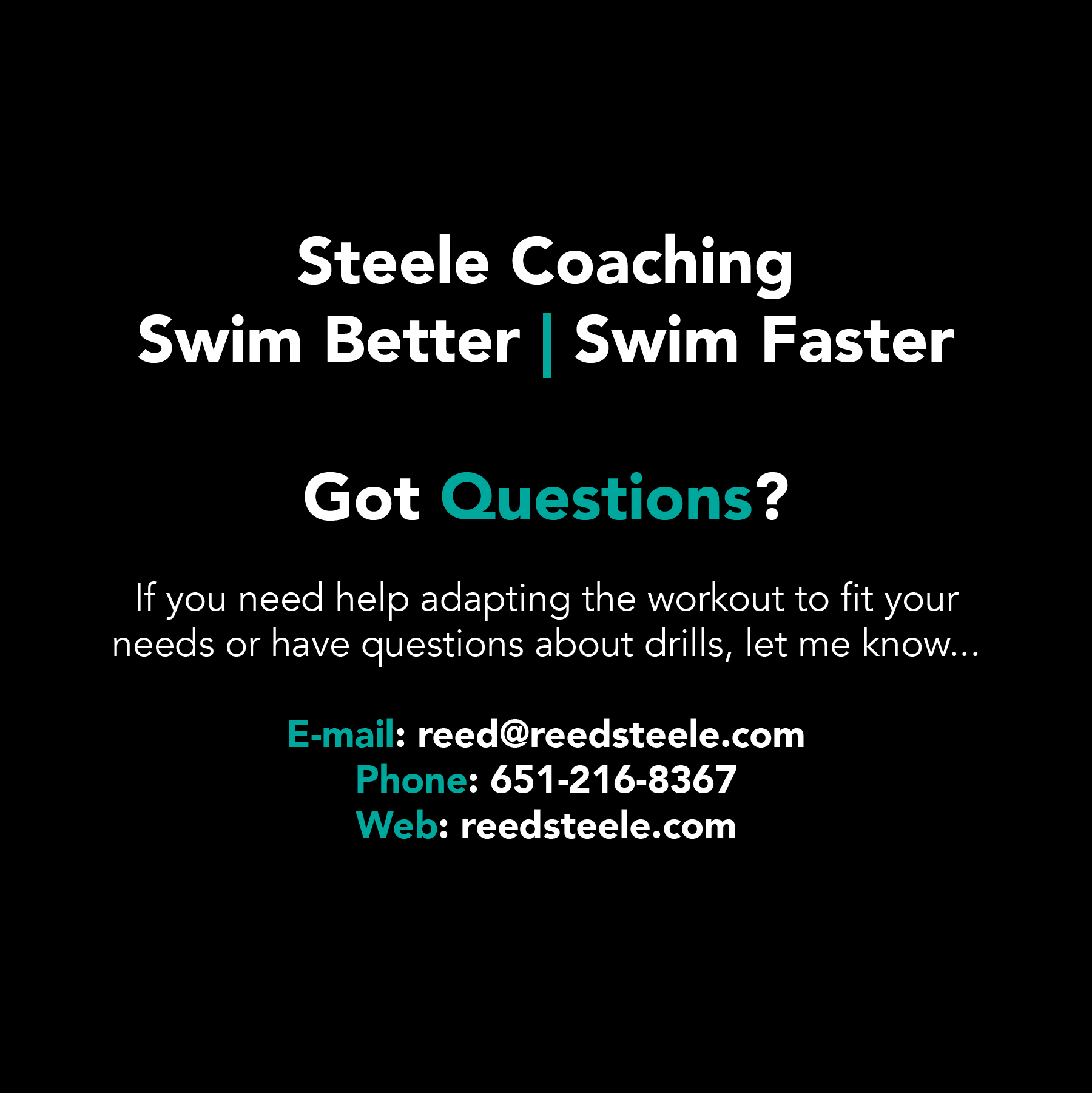Weekly Swim Workout #14
A Guiding Principle
At Steele Coaching, we believe in deliberate practice: being systematic, purposeful, and attentive to details. When you do this, you focus your attention on specific goals that will improve your overall performance.
Deliberate practice opens the door for you to focus on the process rather than the outcome. When you do this on a regular and consistent basis, the outcome takes care of itself.
We help you focus on the little things so that you can improve your performance and finally achieve the BIG things.
Weekly Workout: The Bee
Note: the workout is listed above; what follows is the why / purpose as well as descriptions of workout components and drills
Warm Up
The Warm Up cycles continuously through the following 200:
50 freestyle
50 non-freestyle
25 kayak/25 kick
2 X 25 light build @ R.I. :05
The Main Set is heavy freestyle-focused so the Warm Up includes a bit of variety to ensure adequate warm up of your shoulders while also building in a bit of drill work—kayak drill— to focus on body rotation and the catch portion of your stroke. The light build is designed to help you find a bit of speed in the Warm Upwhile also slightly elevating your heart rate before the Main Set.
Main Set
The Main Set consists of three components—The Eyes, The Body, and The Stinger—which are intended to be done without breaks between the components.
The set within The Eyes are to help you focus on fast swimming with an extra focus on your wall work and your breakouts.
The set within The Body is to help build endurance and to help you understand your different speeds. In short your efforts will go from easy/recovery to build and, finally, to strong.
The set within The Stinger is to, well, create a bit of a sting after you’ve done some hard word. This final portion of the Main Set will help you focus on finding and maintaining your goal 500 pace while you are experiencing significant fatigue.
The Eyes
What follows is an explanation of each of the 50s:
Push off the wall in a tight streamline and hold your streamline until you come to a complete stop. Note that your body will want to turn—use your core to maintain a perfect streamline position. When you come to a complete stop, ramp up to all out freestyle as fast as you can (aim to drive from your legs) and hold this through the turn and into your breakout. After your perfect breakout, shut things down and swim easy for the remainder of the 25.
Hold onto the wall and engage in a 10 second wall kick. At the 10 second mark, flip and complete the 50 in the same way that you did for #1.
If you swim in pool that has the lane line markers on the bottom of the pool that run perpendicular to the way that you are swimming, aim to cross over 5 lines in perfect streamline position while dolphin kicking. If you don’t have the lane line markers, kick to the 10–15 yard mark. At this point, take 4 fast strokes and then shut it down for the remainder of the 25. Repeat for the second 25.
Use the 4th 50 to do what you need to set up for the last 50.
This is an all out (timed) effort while focusing on the drills/focus from the first three 50s.
The Body
This is the bulk of the work within the Main Set. Over 2100 yards, you’ll work on varying your pace per 100 by cycling through three 100s for 7 Rounds at the following intervals: 1:30, 1:20, 1:10. (Note: this set can easily be adapted for different speeds/abilities. Determine a 100 time that pushes your limits over an extended distance and set that as your fastest 100. Then, add 10 seconds to figure out your 2nd internal; add another 10 seconds to figure out your first interval).
Use the 100 at 1:30 to easy into things during Round 1 and then to recover from the 1:10 interval on subsequent Rounds. The 1:30 is designed to be active recovery—lowering your heart rate/flushing your system of lactate while continuing to move.
Use the 100 at 1:20 to find your speed again. Nothing fast here; however, work on finding your power in the water. Think: easy speed.
The final 100 of the series is at 1:10. This should push your limits and be a quick turnaround. In theory, find your speed that you want (+:02) for a goal 500 time.
Goal: for the final two Rounds, aim to continue to hold your pace—for the remaining 6 100s—that you have been hitting on Rounds 1–5 for your 1:10 100s. In other words, there is no active recovery and build to set up for your 100 at 1:10. The remaining 100s are all done at an increased pace, using the interval rest to recover/set-up.
The Stinger
The focus of this set is “feeling” your goal 500 pace (P500) for 50s while in a fatigued state—OUCH! The primary purpose is to help you zero in on your 500 pacing (P500) in the early Rounds, and then aim to maintain that pacing as the fatigue builds up throughout the remainder of the set.
To find your P500, identify your goal time for a 500 and then figure out the pacing that you would need to hold for each 50 of the 500. For example, if your goal 500 is 5:30, you would want to hold :33s for the P500 50s.
Why 50s?
In distance swimming, it’s easy to focus on your 100 times — it makes logical sense. However, when swimmers do this, they often slip into pacing that is slower than their goal pace. By the time they hit the 100 marks, they’ve fallen too far off their pace—it’s hard to get that time back.
Warm Down
Backstroke and sculling for the Warm Down. The Main Set is freestyle focused. Therefore, use the Warm Down to work your shoulders in the opposite direction. Use the sculling to help you find the feel of the water and make sure to vary your hand position of the sculling throughout the Warm Down.

